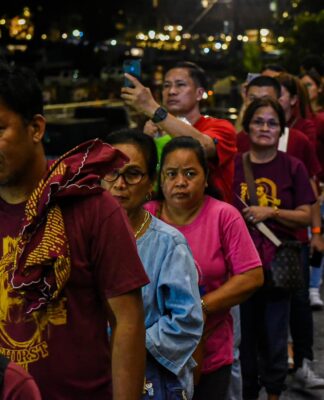 ONE GROUP built a robot, one that could keep an eye on thieves, using cellphone technology.
ONE GROUP built a robot, one that could keep an eye on thieves, using cellphone technology.
Not to be outdone, another group showed how “kamote” could help cure a blood clot-related condition. Still another one proved that with a little dose of yoga, patients suffering from osteoarthritis could still live a meaningful life.
Don’t look far for the year’s best researches. They’re right on campus; courtesy of some of the most creatives and sophisticated minds UST has produced.
Electronics Engineering majors Jennifer Jill Aquino, Seigfred Prado, June Andrew Rabin, Jade Antonette Rico, and Josyl Mariela Rocamora used 3G cellphones to control a robot.
Their thesis, “Tribot: Design of a 3G Cellphone Controlled Clamp and Surveillance Robot via Symbian OS,” is a system represented by a self-designed mobile robot.
The user may control the robot’s movement in different directions, as well as pick and transfer objects, through a cellphone.
“The built-in cameras in the cellular phones allow the user to have a vision of the robot’s surroundings,” said Rocamora, a Bank of the Philippine Islands-Department of Science and Technology science awardee.
Using sweet potatoes or kamote, Pharmacy students Krizia Carla Arzadon, Ana Dominique Cuaresma, Kathleen Anne Lim, Heidi Rose Tanjueco, and Nicole Lynn Kimberly Chan researched on its use to cure a common disease associated with low amount of blood platelets, which are essential in forming blood clots.
Their study titled “Effects of Orally-Administered Decoction of Ipomea batatas (Convulvulaceae) Leaves on Thrombocytopenic Sprague-Dawley Rats” showed that kamote leaves could help treat thrombocytopenia, a condition characterized by a drop in platelet count.
After using “decoction” (extraction done by boiling), the group administered the extracts orally to a number of thrombocytopenic Sprague-Dawley rats, the commonly used species in laboratory experiments.
After a series of tests, the team showed a significant increase in the number of platelets and white blood cells of the rats.
Trying to find a treatment for a certain bone sickness, on the other hand, Nursing students Kairhun Janine Cuadra, Mariz Cuadra, Kim Pearl Cuartero, Carissa Alexandra Cucueco, Gia Patricia Cuevas, Gabriela Cunanan, and Inrid Ayana Custodio studied yoga and working-class patients aged 40 and above to analyze osteoarthritis.
Their study entitled “Samsara: The Lived Experiences of Patients with Osteoarthritis undergoing Yoga Therapy” observed the therapeutic effects of yoga on patients in a phenomenological approach (a detailed observation of the conscious experience).
As the patients passed each level of techniques, the students noticed that they were relieved from pain, and that the mobility and flexibility of the subjects were also improved.
“Yoga served as a way for the patients to resume their usual activities which were formerly hindered by the symptoms of osteoarthritis,” Cucueco said.














